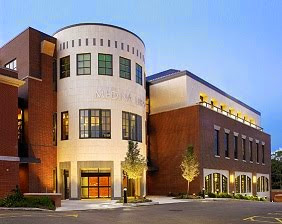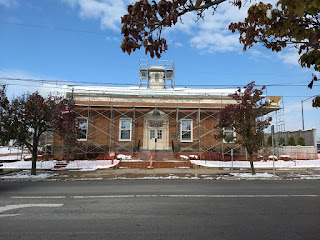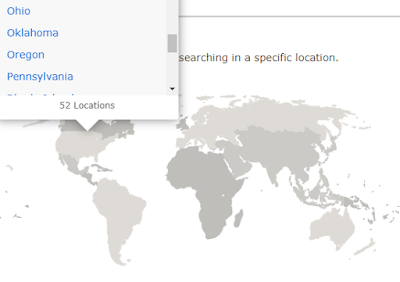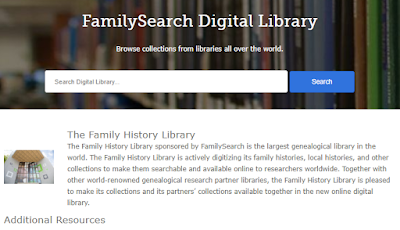 |
| Quote adapted from poem "To A Mouse" by Robert Burns |
I wandered over to 143 West Liberty, and "GASP!"
What was going on!!
I know the city is planning to build a parking garage where the old Masonic Temple used to be and that they were planning to reclaim the property that houses Porter's Shoe Repair, but surely they weren't tearing down this beautiful brick building???
Relax! No, they are not tearing it down.
But it took me awhile to find that out.
I emailed Bob Hyde to see if he knew anything and left a message with the city building department to see what they could tell me. But waiting patiently to hear back from these two prime sources is NOT my style.
So I posted the pictures on the Facebook page, Roadside History of Medina County
Many people were as concerned as I was. Many others posted their memories of going into that building, first when it was a Post Office and later when it became a Federal Office Building. To see the many uses of the building, go to Bob Hyde's Beyond the Storefronts web site: 143 West Liberty
My quest was fulfilled when I saw this post:
RS I know exactly what is going on. I work for the Federal agency GSA and we are refurbishing the fascia and cupola. The building is historical and is going nowhere soon. Project will be done early Dec weather permitting
And in response to the many questions about how it is being used now:
R B Judge Alice Batchelder's office.
 |
| Postcard of the "Old Post Office" circa 1930's |
And the many, many memories from long time Medina residents:
- LH - When I was a kid back in the 50's there was a painting or mural over the customer area. It depicted early settlers harvesting apples in an orchard. Wonder what happened to it or who has it now?
- LH -Worked there in the 80s. USDA.
- D N - Remember going there to sign up for the draft.
- A M- It also had the Social Security office in it.
- DR - My Dad ED Rice was a rural postal carrier and. he worked in this building many years before PO was moved to N. COURT. As a child during snow days at school, he would bring me here and I'd watch him sort mail then ride along with him on his route. What a memory💓
- EL - The mural was a WPA government project to employ people during the depression. I was told it was covered up with paint . Wouldn’t it be wonderful to have that art work restored? I’m not from Medina, but I’ve heard it was beautiful.
- LH - Yeah, walked in and signed up in the U.S.Navy. Left Medina 12 May 1969.
- MAB - I remember it had a fallout shelter sign on it years ago
- SM - Built 1937 by Gibbons-Grable of Canton for $55,791. 1939 12’ mural of apple orchard & bee skeps $750 by Richard Zoellmer native of Portsmouth. Life Mag 12/4/1939 says Zoellner is a muralist and watercolor painter studio in Cincinnati.
- SM - an example of New Deal artwork: “Gathering the Apple Crop,” an oil-on-canvas mural by Richard Zoellner. Completed in 1938
- EL - Thank you SM. When I heard it was covered up I was shocked since I had seen other WPA art work in other public places and it was an exquisite style of art. I wonder if a professional restorer could uncover it with the technology of today?
And the discussion continues...
So between Bob Hyde's information about the site on his web page and all the information uncovered on the Facebook page Roadside History of Medina County, there is no need for me to do a blog post on the building. Sigh...
So, what are you reading?!?
Definition of crowdsourcing
: the practice of obtaining needed services, ideas, or content by soliciting contributions from a large group of people and especially from the online community rather than from traditional employees or suppliers
Which describes what I did! I used traditional sources print and otherwise, and turned to an online resource - The FaceBook group Roadside History of Medina County.
Not only did I get the answer to my question, the discussion went much further, much faster when members of the group contributed their personal memories of the building. It would have taken me weeks to track down that many people and interview them.
I thank each and everyone of them for providing a much richer view of a piece of Medina's History!
SOURCES:
So, what are you reading?!?
A blog about the power of crowd sourcing!
Merriam Webster defines crowd sourcing as:Definition of crowdsourcing
: the practice of obtaining needed services, ideas, or content by soliciting contributions from a large group of people and especially from the online community rather than from traditional employees or suppliers
Which describes what I did! I used traditional sources print and otherwise, and turned to an online resource - The FaceBook group Roadside History of Medina County.
Not only did I get the answer to my question, the discussion went much further, much faster when members of the group contributed their personal memories of the building. It would have taken me weeks to track down that many people and interview them.
I thank each and everyone of them for providing a much richer view of a piece of Medina's History!
SOURCES:


















